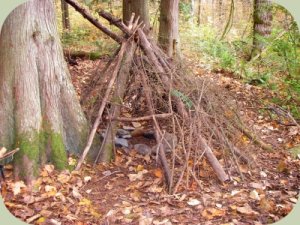Basics of Wilderness Survival Shelters

By Jason Knight
Understanding how to create effective wilderness survival shelters is one of the most important outdoor skills. From keeping you protected from the elements to providing a place to rest, wilderness shelters serve a key role in survival situations. Not only do they provide for physical needs, but also help create a sense of home in the wilderness. Though each season and environment presents its own challenges, there are several universal principles for creating effective wilderness survival shelters:
Location
The most important aspect of making wilderness shelters is choosing a good location. A good location is one that 1) provides easy access to ample building materials such as dead sticks, leaves, and grasses; and is 2) away from major hazards such falling branches, pooling water, and insect nests. You also want a location that has a large enough flat area to allow you to lie down and sleep comfortably.
Size
A common mistake when building survival shelters is to build them too large. Not only does it take more materials, effort, and time to construct, but often ends up being cold due to the amount of space on the inside. Effective wilderness shelters are often small on the inside - just large enough to fit your body to conserve body heat.
Structure
All shelters need to be constructed with safety in mind. Large strong branches can provide the initial framework for many types of survival shelters. Typically, branches used for framework should be strong enough to easily support the weight of an adult. This is especially important for lean-to and debris hut style shelters.
Insulation and Cover
Whether you are in a hot and sunny environment or a cold and wet forest, insulation and cover is important to keep you protected from the outside elements. Leaves, grasses, small sticks, ferns, and pine needles are types of debris that can be used for insulation. Be sure to layer large amounts of debris on your shelter. Also, don't forget to use debris to create a thick mattress on the inside of your shelter to insulate you from the cold ground. Bark or soil can be added on the top and sides of your shelter to create a barrier from cold wind and rain.
Heat Source
In cool and cold environments the
primary shelter concern is staying warm to avoid hypothermia. With
wilderness survival shelters, there are typically two choices for a heat
source: your own body heat or heat from a fire. Wilderness shelters
that rely on your own body heat as the primary heat source (such as a
debris hut), need to be small on the inside and have lots of extra
insulating debris (imagine your mummy sleeping bag with ten times as
much insulation). If you plan to use a fire on the inside of your
shelter as a heat source, carefully plan how it will be tended all
night, be sure to collect a full night's worth of firewood before dark,
and be extra careful not to burn down your shelter!
Be More Prepared For Your Next Outdoor Adventure!

Don't leave without knowing these six essential survival skills. Our free survival mini guide reveals the strategies of:
- Shelter & fire to prevent the number one cause of death
- Obtaining clean water to avoid life-threatening dehydration
- Common wild survival foods and other critical skills!

Types of Wilderness Survival Shelters
The type of shelter you choose depends on many factors including what materials are available, environmental conditions, choice of heat source, and whether it will be a personal or group shelter. A great personal shelter heated by your own body heat is a debris hut. Check out our article about how to make a debris hut.
Lean-to shelters can work well as a relatively safe,
fire-heated personal shelter:

The debris tipi is a great fire-heated shelter for a group:

When planning a trip think about which types of survival shelters would be the best options for the season and environment you will be in. A great habit is to practice noticing good shelter locations while hiking.
Building wilderness survival shelters can be quite fun and rewarding. Spending a night in a shelter built in one day with your own hands provides an amazing sense of self sufficiency and accomplishment. With an understanding of the basic principles and hands-on practice, wilderness survival shelters can help you weather almost any survival situation.
By the way, if you enjoyed this article then you'll love our survival mini guide. You'll discover six key strategies to staying alive in the outdoors plus often-overlooked survival tips. We're currently giving away free copies here.
Additional Resources
Seven Primitive Shelters That Could Save Your Life - Field & Stream
Related Courses
Wilderness Survival Courses at Alderleaf

About the Author: Jason Knight is a cofounder of Alderleaf Wilderness College and the author of The Essential Skills of Wilderness Survival. He has been teaching wilderness skills for over twenty-five years. Learn more about Jason Knight.
Return from Wilderness Survival Shelters back to Survival Articles
Is The Essential Wilderness Survival Skills Course Right for You? Take the "Online Survival Training Readiness" Quiz
See for yourself if this eye-opening course is a good fit for you. It takes just a few minutes! Get your Survival Training Readiness Score Now!

Grow Your Outdoor Skills! Get monthly updates on new wilderness skills, upcoming courses, and special opportunities. Join the free Alderleaf eNews and as a welcome gift you'll get a copy of our Mini Survival Guide.

 The Six Keys to Survival: Get a free copy of our survival mini-guide and monthly tips!
The Six Keys to Survival: Get a free copy of our survival mini-guide and monthly tips!
Learn more